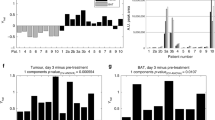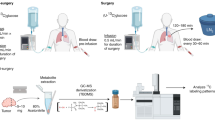Summary
Arterial blood pressure and relevant parameters of the arterial blood (O2 and CO2 tensions, pH, haematocrit, serum electrolytes and osmolality) were determined in tumour-bearing rats upon local hyperthermia (HT) and/or hyperglycaemia (HG). Tumour heating was performed in a saline bath (44‡ C) for 120 min; hyperglycaemia was induced by i.v. infusion of 40% glucose solution for 150 min [blood glucose levels: 35–40 mM during heating; total amount of glucose: 1.19 g/100 g body wt.; infusion rates: 0.31 ml (100 g body wt.)−1 min−1 for 2 min, 0.02 ml (100 g body wt.)−1 min−1 for 88 min, and 0.01 ml (100 g body wt.)−1 min−1 for 60 min]. Immediately after treatment, glucose, lactate and ATP levels were determined in tumour and muscle specimens and compared to these values under normothermic (NT) and/ or normoglycaemic (NG) conditions. In all groups (NT/ NG, NT/HG, HT/NG, HT/HG) there were only minor but characteristic changes in blood parameters, which were mainly due to the volume and type of the infused fluids (glucose solution, saline). During hyperglycaemia, tumour glucose levels rose 13-to 17-fold, whereas muscle glucose concentrations exhibited only a 3-to 5-fold increase; lactate levels were 1.9–2.5 times higher in tumours than in muscle, indicating an increase in the metabolic differences between normal and malignant tissues. Despite an increased glucose availability, tumours did not show an improved energy status and, thus, would not be expected to develop a decrease in thermal sensitivity or stimulation in growth rate. The good systemic tolerability of the combined treatment (HT/HG) and the differential changes in malignant and normal tissue occurring under these conditions, support further attempts to manipulate tumour metabolic environment by glucose in order to achieve better therapeutic results.
Similar content being viewed by others
Abbreviations
- HG:
-
hyperglycaemia
- HT:
-
hyperthermia
- NG:
-
normoglycaemia
- NT:
-
normothermia
References
Ardenne M von (1966) Syncarcinokolyse in Gestalt der Mehrschritt-Therapie. In: Doerr W, Lindner F, Wagner G (eds) Aktuelle Probleme aus dem Gebiet der Cancerologie. Springer, Berlin Heidelberg New York, pp 128–143
Ardenne M von, Reitnauer PG (1990) Hyperglycemia as obligatory, synergistic supplement of hyperthermia in cancer therapy. On the mechanism of manipulated microcirculation inhibition in tumour tissue. Dtsch Z Onkol 22:83–95
Ardenne M von, Reitnauer PG, Schmidt D (1969) Theoretische Grundlagen und In-vivo-Messungen zur Optimierung der selektiven übersÄuerung von Krebsgewebe. Acta Biol Med Germ 22:35
Bork R, Vaupel P, Thews G (1975) Atemgas-pH-Nomogramme für das Rattenblut bei 37‡ C. AnÄsthesist 24:84–90
Calderwood SK, Dickson JA (1980) Effect of hyperglycemia on blood flow, pH, and response to hyperthermia (42‡ C) of Yoshida sarcoma in the rat. Cancer Res 40:4728–4733
DiPette DJ, Ward-Hartley KA, Jain RK (1986) Effect of glucose on systemic hemodynamics and blood flow rate in normal and tumor tissues in rats. Cancer Res 46:6299–6304
Evelhoch JL, Sapareto SA, Jick DEL, Ackerman JJH (1984) In vivo metabolic effects of hyperglycemia in murine radiation-induced fibrosarcoma: a31P NMR investigation. Proc Natl Acad Sci USA 81:6496–6500
Gerweck LE, Urano M, Koutcher J, Fellenz MP, Kahn J (1989) Relationship between energy status, hypoxic cell fraction, and hyperthermic sensitivity in a murine fibrosarcoma. Radiat Res 117:448–458
Gullino PM, Grantham FH, Smith SH (1965) The interstitial water space of tumors. Cancer Res 25:727–731
Gullino PM, Grantham FH, Courtney AH (1967) Glucose consumption by transplanted tumors in vivo. Cancer Res 27:1031–1040
Hahn GM (1982) Hyperthermia and cancer. Plenum, New York
Jain JK, Shah SA, Finney PL (1984) Continuous noninvasive monitoring of pH and temperature in rat Walker 256 carcinoma during normoglycemia and hyperglycemia. J Natl Cancer Inst 73:429–436
Jung C, Mueller-Klieser W, Vaupel P (1984) Tumor blood flow and O2 availability during hemodilution. Adv Exp Med Biol 180:281–291
Kalmus J, Okunieff P, Vaupel P (1989) Effect of intraperitoneal versus intravenous glucose administration on laser Doppler flow in murine FSaII tumors and normal skin. Cancer Res 49:6313–6317
Koutcher JA, Fellenz MP, Vaupel PW, Gerweck LE (1988) FSaII mouse tumor metabolic changes with different doses of glucose measured by31P nuclear magnetic resonance. Cancer Res 48:5917–5921
Koutcher JA, Barnett D, Kornblith AB, Cowburn D, Brady TJ, Gerweck LE (1990) Relationship of changes in pH and energy status to hypoxic cell fraction and hyperthermia sensitivity. Int J Radiat Oncol Biol Phys 18:1429–1435
Krag DN, Storm FK, Morton DL (1990) Induction of transient hyperglycaemia in cancer patients. Int J Hyperthermia 6:741–744
Okunieff P, Vaupel P, Sedlacek R, Neuringer LJ (1989) Evaluation of tumor energy metabolism and microvascular blood flow after glucose and mannitol administration using31P nuclear magnetic resonance spectroscopy and laser Doppler flowmetry. Int J Radiat Oncol Biol Phys 16:1493–1500
Orvoine RH, Letellier G, Lapointe Y (1983) Systemic tolerance of osmotically induced oncolysis in rats. J Natl Cancer Inst 70:881–889
Reiss M, Hochwald A (1932) Experimentelle Beeinflussung des Tumorstoffwechsels am lebenden Tier. Med Klinik 28:1391–1395; 1432–1434
Ross BD, Mitchell SL, Merkle H, Garwood M (1989) In vivo31P and2H NMR studies of rat brain tumor pH and blood flow during acute hyperglycemia: differential effects between subcutaneous and intracerebral locations. Magn Reson Med 12:219–234
Sauer LA, Dauchy RT (1987) Stimulation of tumor growth in adult rats in vivo during acute streptozotocin-induced diabetes. Cancer Res 47:1756–1761
Sevick EM, Jain RK (1989) Viscous resistance to blood flow in solid tumors: effect of hematocrit on intratumor blood viscosity. Cancer Res 49:3513–3519
Shah SA, Jain RK, Finney PL (1983) Enhanced metastasis formation by combined hyperthermia and hyperglycemia in rats bearing Walker 256 carcinosarcoma. Cancer Lett 19:317–323
Shapot VS (1980) Biochemical aspects of tumour growth. MIR Moscow
Streffer C (1988) Aspects of metabolic change after hyperthermia. Rec Res Cancer Res 107:7–16
Streffer C (1990) Biological basis of thermotherapy. In: Gautherie M (ed) Biological basis of oncologic thermotherapy. Springer, Berlin Heidelberg New York, pp 1–71
Tannock IF, Rotin D (1989) Acid pH in tumors and its potential for therapeutic exploitation. Cancer Res 49:4373–4384
Urano M (1988) Tumor response to hyperthermia. In: Urano M, Douple E (eds) Hyperthermia and oncology, vol 1, VSP, Utrecht, pp 161–200
Urano M, Montoya V, Booth A (1983) The effect of hyperglycemia on the thermal response of murine normal and tumor tissues. Cancer Res 43:453–455
Urano M, Todoroki T, Kahn J, Okunieff P (1987) The effect of hyperglycemia on the tumor response to irradiation given alone or in combination with hyperthermia. Radiat Res 111:488–497
Vaupel P (1990) Pathophysiological mechanisms of hyperthermia in cancer therapy. In: Gautherie M (ed) Biological basis of oncologic thermotherapy. Springer, Berlin Heidelberg New York, pp 73–134
Vaupel P, Okunieff P (1988) Role of hypovolemic hemoconcentration in dose-dependent flow decline observed in murine tumors after intraperitoneal administration of glucose or mannitol. Cancer Res 47:7102–7106
Vaupel P, Otte J, Manz R (1982) Oxygenation of malignant tumors after localized microwave hyperthermia. Radiat Environ Biophys 20:289–300
Vaupel P, Kallinowski F, Kluge M (1988) Pathophysiology of tumours in hyperthermia. Rec Res Cancer Res 107:65–75
Vaupel P, Okunieff P, Kluge M (1989a) Response of tumour red blood cell flux to hyperthermia and/or hyperglycaemia. Int J Hyperthermia 5:199–210
Vaupel P, Kallinowski F, Okunieff P (1989b) Blood flow, oxygen and nutrient supply, and metabolic environment of human tumors. A review. Cancer Res 49:6449–6465
Ward KA, Jain RK (1988) Response of tumors to hyperglycaemia: characterization, significance and role in hyperthermia. Int J Hyperthermia 4:223–250
Ward-Hartley KA, Jain RK (1987) Effects of glucose and galactose on microcirculatory flow in normal and neoplastic tissues in rabbits. Cancer Res 47:371–377
Author information
Authors and Affiliations
Additional information
Supported by Volkswagen Foundation, grant no. I/65 084
Rights and permissions
About this article
Cite this article
Krüger, W., Mayer, W.K., Schaefer, C. et al. Acute changes of systemic parameters in tumour-bearing rats, and of tumour glucose, lactate, and ATP levels upon local hyperthermia and/or hyperglycaemia. J Cancer Res Clin Oncol 117, 409–415 (1991). https://doi.org/10.1007/BF01612759
Received:
Accepted:
Issue Date:
DOI: https://doi.org/10.1007/BF01612759




